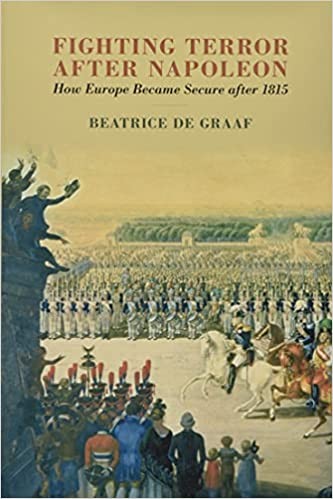Publisher’s presentation:
- After twenty-six years of unprecedented revolutionary upheavals and endless fighting, the victorious powers craved stability after Napoleon’s defeat in 1815. With the threat of war and revolutionary terror still looming large, the coalition launched an unprecedented experiment to re-establish European security. With over one million troops remaining in France, they established the Allied Council to mitigate the threat of war and terror and to design and consolidate a system of deterrence. The Council transformed the norm of interstate relations into the first, modern system of collective security in Europe. Drawing on the records of the Council and the correspondence of key figures such as Metternich, Castlereagh, Wellington and Alexander I, Beatrice de Graaf tells the story of Europe’s transition from concluding a war to consolidating a new order. She reveals how, long before commercial interest and economic considerations on scale and productivity dictated and inspired the project of European integration, the common denominator behind this first impulse for a unification of Europe in norms and institutions was the collective fight against terror.
- Helps us to understand how a unified Europe came to be constructed around the collective fight against terror after 1815
- Examines the Allied Council, and its history, on the basis of new archives
- Uncovers the emergence of secret police, black lists, border control and fortifications, and financial securities, in and around Europe
Contents
Prologue, 1. Introduction: Napoleon’s frustration
2. Providence in Paris
3. Balancing in a climate of distress
4. ‘A moderate occupation’
5. ‘Fausses nouvelles’ and ‘Black lists’: the Allied struggle against ‘armed Jacobinism’
6. Fighting ‘terroristes’ together: towards a ‘European police directorate’?
7. The price of security
8. Fortress Europe: constructing the ‘Wellington barrier’
9. Beyond Europe
10. Conclusion
Bibliography.In this video interview and powerpoint (video, 1h1m), Beatrice de Graaf talks with Professor Alexander Mikaberidze about this book.
Podcast Interview (50m) with Beatrice de Graaf by George Giannakopoulos, historian of Modern Britain and Europe
About the author, Beatrice de Graaf
Beatrice de Graaf is Distinguished Professor and holds the Chair of History of International Relations at Utrecht University. She was awarded the Stevin Prize in 2018, the highest distinction in Dutch academia. The Dutch version of this book, Tegen de terreur: Hoe Europa veilig werd na Napoleon, was shortlisted for the Libris Prize.


